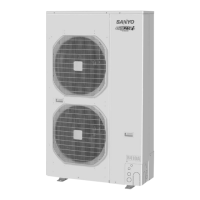
Do you have a question about the Sanyo Big PACi 18 Series and is the answer not in the manual?
| Brand | Sanyo |
|---|---|
| Model | Big PACi 18 Series |
| Category | Air Conditioner |
| Language | English |
Detailed specifications for various indoor and outdoor unit types and configurations.
Lists key components and their specifications for indoor and outdoor units.
Details specifications for secondary components like transformers, sensors, and valves.
Provides physical dimensions and installation clearances for indoor and outdoor units.
Illustrates the refrigerant circuit for cooling and heating cycles.
Specifies the operational temperature and humidity ranges for cooling and heating.
Shows how cooling and heating capacities vary with temperature conditions.
Presents sound pressure level data across different frequencies for various unit types.
Details fan performance curves related to static pressure and airflow.
Illustrates airflow distribution patterns for different indoor unit types.
Provides precautions and guidelines for installing fresh air intake systems.
Covers tubing length, elevation, and distribution joint installation guidelines.
Lists essential checks and preparations before initiating the unit's test run.
Highlights important safety and operational considerations for unit testing.
Outlines the step-by-step process for conducting a unit test run using the remote controller.
Specifies critical pre-test checks for safe and accurate operation.
Details how to use the remote controller to initiate and manage the test run mode.
Provides essential safety warnings and handling instructions for test runs.
Lists error codes, their causes, and corresponding correction procedures for specific unit types.
Explains wiring configurations for multi-system, group, and remote controller control.
Provides wiring and schematic diagrams for various indoor unit types.
Offers wiring and schematic diagrams for outdoor units.
Describes the operational logic for indoor air temperature and compressor frequency control.
Details the layout and functions of components on the outdoor unit's control PCB.
Explains the switches and functions on the indoor unit's control PCB.
Lists alarm codes displayed on the remote controller and their possible causes.
Explains the meaning of LED indicators on the outdoor unit's control PCB.
Correlates alarm symptoms with potential faulty parts and troubleshooting steps.
Provides detailed explanations and diagnostic flows for specific alarm messages.
Lists resistance values for temperature sensors (thermistor) at different temperatures.
Details the procedure for safely removing the compressor, including precautions.
Outlines the steps for removing the electrical component box from the outdoor unit.
Introduces the outdoor unit maintenance remote controller and its purpose.
Lists the various functions available on the maintenance remote controller.
Explains basic operations like start/stop, mode switching, and test runs.
Describes how to view sensor data from indoor and outdoor units.
Details how to access and view past alarm records from the outdoor unit.
Explains how to access and modify settings stored in the outdoor unit's EEPROM.
Allows basic adjustments like filter lifetime, mode priority, and central control settings.
A comprehensive list of configurable items and their available settings for simple adjustments.
Enables advanced configuration of system, unit, and group addresses.
A detailed list of advanced settings and their options for fine-tuning unit behavior.
Provides specific filter sign ON time settings for various indoor unit models.
Lists detailed settings for fan tap, humidifier, and flap operations.
Explains functions for test runs, sensor monitoring, and system diagnostics.
Describes how to operate the unit with the thermostat forced ON for testing.
Highlights factors that can interfere with wireless signal reception and installation.
Advises on proper placement and environmental considerations for remote control installation.
Step-by-step guide for physically installing the wireless receiver unit into the indoor unit.
Lists all components and accessories included with the wireless remote controller kit.
Provides wiring diagrams and connection instructions for the receiver unit.
Offers guidelines for using both wired and wireless controllers simultaneously.
Explains how to perform a test run after installing the wireless receiver and remote.
Details how to set address switches on the receiver to avoid interference.












